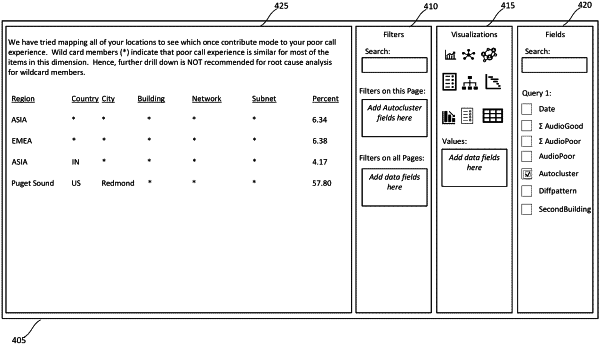| CPC G06F 16/248 (2019.01) [G06F 16/285 (2019.01); G06N 20/00 (2019.01)] | 20 Claims |

|
1. A data processing system comprising:
a processor; and
a machine-readable medium storing executable instructions for causing the processor to perform operations comprising:
analyzing performance data associated with a communications platform to generate a multidimensional representation of the performance data;
presenting, on a display of the data processing system, a user interface of a data analysis platform for constructing queries of the multidimensional representation of the performance data and for creating visualizations of the performance data for diagnosing a first performance problem of the communications platform;
receiving, via the user interface, a first user input defining first query parameters for a first query via the user interface, the first query parameters including a first aggregation operator for invoking a first machine learning algorithm configured to analyze the performance data in the multidimensional representation of the performance data to identify clusters of data indicative of a cause of a first performance problem of the communications platform, wherein each dimension of the multidimensional representation of the performance data represents a logical group of the performance data according to one or more shared attributes;
constructing the first query based on the first user input;
automatically executing the first query on the performance data using the first query parameters to generate first query results by invoking the first machine learning algorithm on the performance data to automatically identify a plurality of first clusters of data indicative of the first performance problem;
automatically identifying a set of first cluster properties associated with each cluster of the plurality of first clusters of data by performing a comparison on multiple dimensions of the performance data to identify values or combinations of values in the performance data indicative of the cause of the first performance problem;
automatically identifying a first subset of the set of first cluster properties for which the first query results are further refinable into one or more subcategories of properties to identify contributing factors to the first performance problem and a second subset of the set of first cluster properties which cannot be broken down into one or more subcategories of properties to further refine the first query results;
presenting, via the user interface, a first visualization of the first query results, wherein the first visualization includes information for diagnosing the first performance problem, wherein the first visualization includes one or more first indicators identifying the first subset of the set of first cluster properties for which the first query results are further refinable into one or more subcategories of properties and one or more second indicators identifying the second subset of the second subset of the set of first cluster properties which cannot be broken down into one or more subcategories of properties to further refine the first query results, and wherein the one or more first indicators are actuatable to cause the processor to automatically update and re-execute the first query based on a respective indicator of the one or more first indicators that is actuated;
receiving, via the user interface, a second user input actuating a respective indicator of the one or more first indicators;
automatically updating the first query parameters to include a respective first cluster property associated with the respective indicator responsive to the second user input to produce second query parameters;
constructing a second query based on the second query parameters;
automatically executing the second query on the performance data using the second query parameters to generate second query results by invoking the first machine learning algorithm on the performance data to automatically identify a plurality of second clusters of data indicative of the first performance problem; and
presenting, via the user interface, a second visualization of the second query results.
|